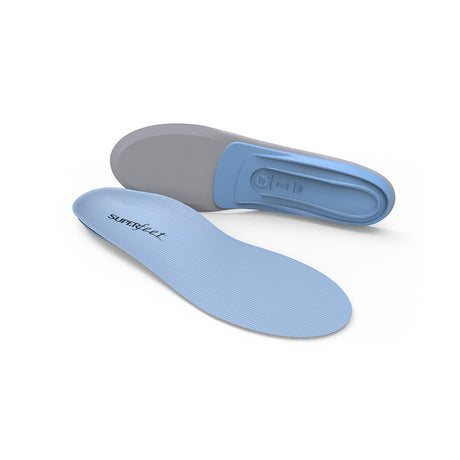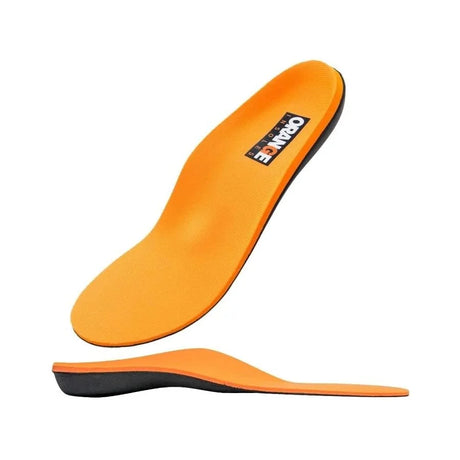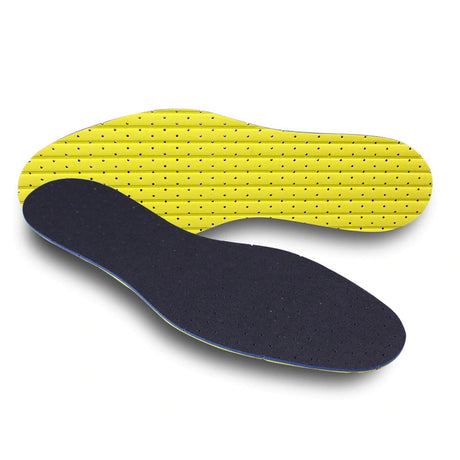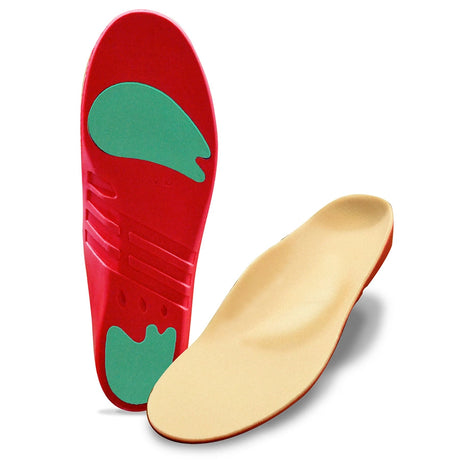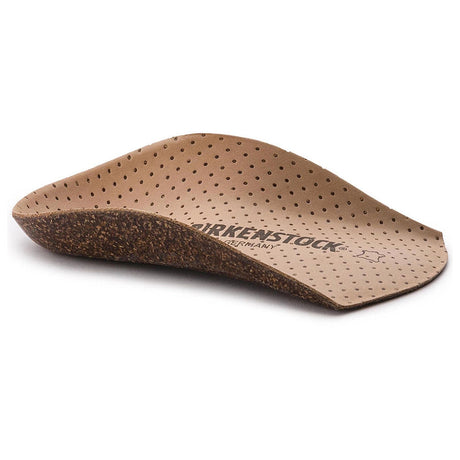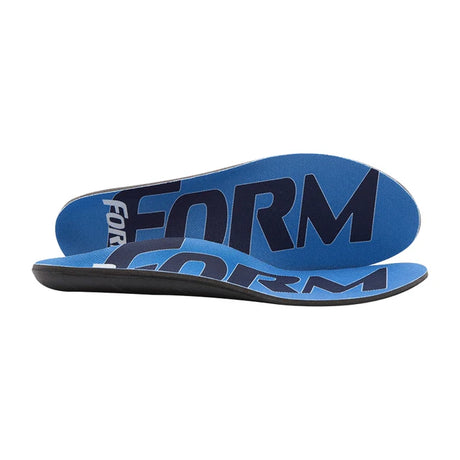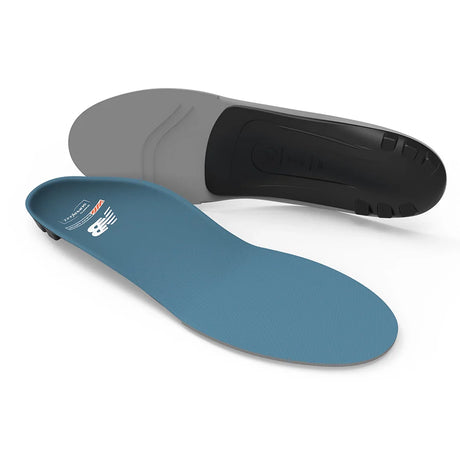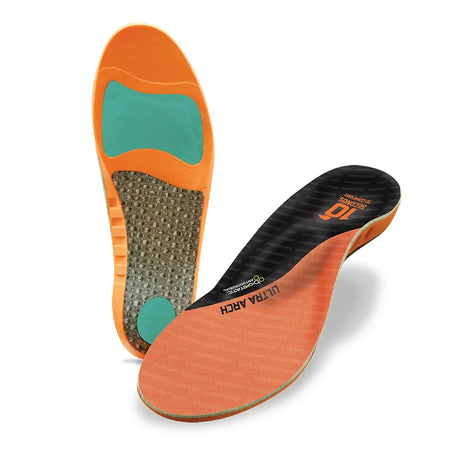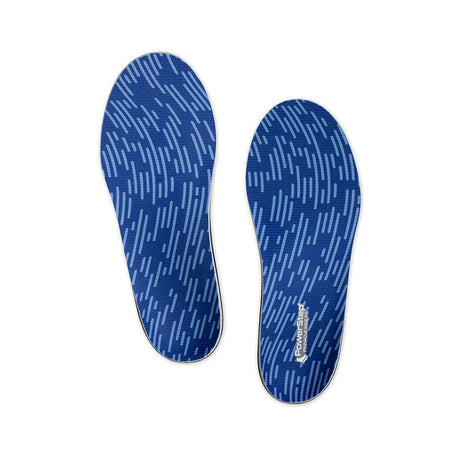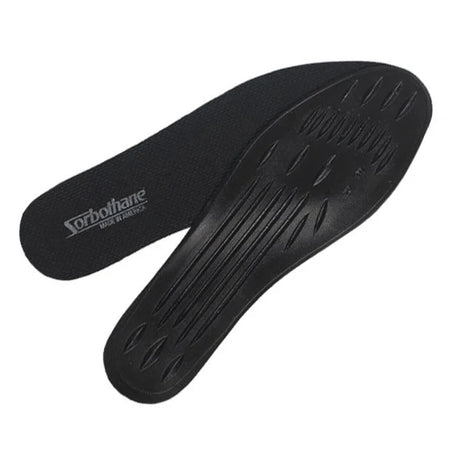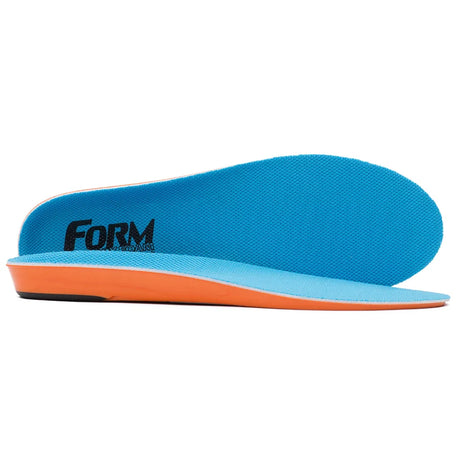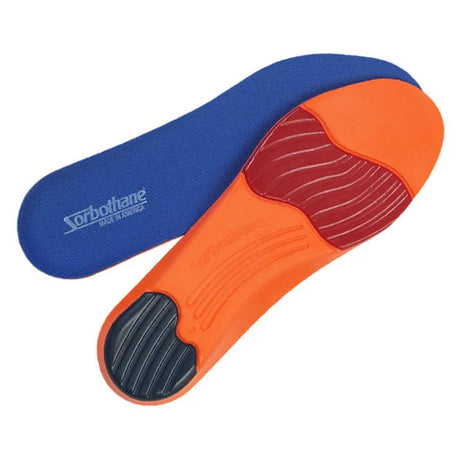Categories
No products found
About Insoles
What are insoles?
What are insoles?
An insole is a device placed inside a shoe to provide enhanced cushioning, support, and overall foot comfort when wearing and using footwear.
Insoles sit under the foot, but on top of the sole inside of the shoe. This separates your foot from the bottom of the shoe, which can often be uncomfortable.
What are the benefits of insoles?
What are the benefits of insoles?
Most insoles provide some degree of enhanced cushioning, foot support, and shock absorption, which in turn will improve overall foot comfort.
Each insole has a variety of features that distinguish it from other insoles. Some might provide greater foot support and less cushioning, while others might provide more cushioning but minimal support.
All insoles, however, are designed to ensure that your foot remains comfortable while wearing your shoes.
How do I choose an insole?
How do I choose an insole?
The first step is to understand why you're looking for an insole. This might be due to general foot discomfort, athletic activities, a medical condition, or even just because your old shoe insoles are worn out and need replacing.
From there, you can narrow the selection down to only products that will meet your needs. For example, you might look for insoles that are full-length, suitable for plantar fasciitis, suitable for running, or offer a semi-rigid arch support. This will give you a selection to choose from that match your general requirements. You could then narrow the selection down even further based on your shoe size, arch height, and more if necessary.
To help make finding products easier, use our product collections and product filters to narrow down our selection of insoles to see only insoles that meet your needs. You can also compare multiple products by clicking the "Compare" option when looking at products on this page.
For a more in-depth guide to selecting insoles, check out our Insole Guide.
What is the difference between rigid, semi-rigid, and flexible arch supports?
What is the difference between rigid, semi-rigid, and flexible arch supports?
Insoles with a rigid arch support will flex extremely little under pressure. If you imagine holding the insole in both hands, with one hand on the midfoot of the insole and the other on the heel, if you were to try and bend the arch of the insole it would be extremely difficult to do so and the insole would flex very little. This type of arch support is effective for providing maximum foot support, but will provide very little flexibility during activities such as running.
Insoles with a flexible arch support are essentially the opposite. This type of arch support will freely flex under pressure. If you again imagine holding the insole in both hands, if you were to bend the insole, the insole would freely bend over into itself. This type of arch support is great for providing gentle support and overall cushioning for the foot and arch, but may not provide enough support for conditions such as plantar fasciitis.
Semi-rigid arch support insoles are between the other two options. They will flex under pressure, but will resist fully bending. This arch support type is ideal for most situations, as the support will resist flattening under pressure and will keep the foot and arch supported, while at the same time also allowing your foot to flex more freely.
How important is arch height when choosing an insole?
How important is arch height when choosing an insole?
In general, we'd say that it's pretty important particularly when ordering a semi-rigid or rigid arch support. This is because if you were to order a high-arch insole and your feet have low arches, the support provided by the insole might feel like it's putting excess pressure on the arch of your foot. Your foot is likely to adjust to the new arch height over time, but it may cause unnecessary discomfort at first. Flexible support insoles tend to compress more easily, making arch height less of a factor, but it's still worth considering.
Most people can be comfortable in an insole that matches their foot arch height and one direction either side. Most people who have low-arched feet, for example, can generally be comfortable when wearing either a low-arch or medium-arch insole, but generally not a high-arch insole. It's usually best to find an insole that matches your foot arch height, however.
The classification of what defines a high, medium, and low-arch insole varies somewhat between manufacturers, but in general we classify arch heights based on the following:
- Low arch: Arch height of 20mm or less.
- Medium arch: Arch height around 25mm, usually 22-27mm.
- High arch: Arch height 28mm or greater, with most high arch insoles 30mm or greater.
In essence, the higher the arch height of the insole compared to the arch height of your foot, the more support you'll feel when wearing the insole, and vice versa.
For an easy at-home way to determine your foot arch height, you can perform what's called the "wet test."
Should I buy a full-length or 3/4-length insole?
Should I buy a full-length or 3/4-length insole?
For most people, we always recommend a full-length insole. This provides the most comprehensive comfort and support and is the easiest to fit and use in your shoes.
The only time we typically will recommend a 3/4-length insole would be in situations where there's not enough room in your shoe for a full-length insole (for example, in a shoe where the factory insole cannot be removed and a full-length insole wouldn't leave enough room in the toe-box of the shoe for your foot to fit comfortably).
Does the material the insole is made of really matter?
Does the material the insole is made of really matter?
Each material that you'll typically find in an insole has its own advantages and disadvantages.
EVA foam insoles are the most common type of insoles. EVA foam is great for absorbing pressure while still maintaining its shape, and insoles made of this material are lightweight and easy to trim if necessary.
Gel insoles are excellent for absorbing impact shock, but they tend to not hold their shape well under pressure and tend to be relatively heavy compared to insoles made of other materials.
Cork insoles are breathable and rigid to ensure that their shape is maintained, but they tend to lacks some of the cushioning properties of insoles made from other materials.
Memory foam insoles are great for having a nice layer of plush cushioning that will not only improve pressure relief but will also conform to your feet over time. The major downside to memory foam is that it compresses much easier than EVA foam and may not hold its shape as long.
Lastly, carbon fiber insoles and insoles made from other similar composites are extremely rigid and ensure maximum support, but they don't flex freely.
How are insoles sized?
How are insoles sized?
Many insoles are "trim to fit" and cover a range of multiple shoe sizes. For example, an insole might come in the sizes "Women's 5-7," "Women's 7.5-9.5," and "Women's 10-12." In such cases, you would order the size option that your typical shoe size falls into, then would trim the insoles to match your footwear.
For instance, if you wear a Men's 10 shoe and the insole you were looking at came in a "Men's 9.5-11" size option, that would be the option you would order. Once the insole arrives, you would simply trim any excess length from the insole to fit your shoe.
Some insoles are not trim-to-fit and offer an option for each individual whole or half shoe size. In this case, order the insole option that most closely corresponds with the shoe size you typically wear.
What size do I choose if I'm between two size options?
What size do I choose if I'm between two size options?
For trim-to-fit insoles, where the shoe size range for each insole option covers at least 1 whole shoe size or more (example: "Men's 10-11.5"), we suggest sizing up to the next size. For instance, if you wear a Women's 8.5 shoe and the options for the insole you're looking at are "Women's 7-8" and "Women's 9-10", you'll want to select the "Women's 9-10" option. Since the insole is trimmable, you can always trim it to fit your shoes, and it's always better to have the insole run the entire length of the shoe and not have a gap between the tip of the insole and the toe of the shoe.
For insoles that are not trim-to-fit, however, we suggest sizing down. So, for example, if you wear a Men's 10.5 shoe and the insole you're looking at comes in a "Men's 10" and "Men's 11" option, go with the "Men's 10" option. Since these insoles cannot be trimmed, we want to avoid the insole being too long for your shoes and the tip of the insole curling/buckling inside the shoe as a result.
Will insoles work as soon as I try them?
Will insoles work as soon as I try them?
This depends on how similar the new insoles are to what you had been using previously. If the new insoles are similar in overall shape and level of support, yes, you should be able to wear the new insoles right away.
If your new insoles are a big change from what you've been using, your feet might need a little bit of time to adjust to the new shape and support that the new insoles provide. In this case, using the new insoles for only a few hours at a time for the first few days is recommended to help your feet adjust.
What happens if I'm not 100% sure I'll like my new insoles?
What happens if I'm not 100% sure I'll like my new insoles?
Great question! It can take a few weeks to fully know whether or not a new insole is performing the way we'd like it to or not. We and many of the brands we carry understand this, and most insoles are covered by what we call a "Wear Test Guarantee": If you buy an insole, try it, and it simply isn't working for you, you're more than welcome to return or exchange it.
We strongly recommend trying an insole for a few weeks before making your final determination on how well it works. In many cases, it can take a full week or more to feel the effects of a new insole on foot comfort.

